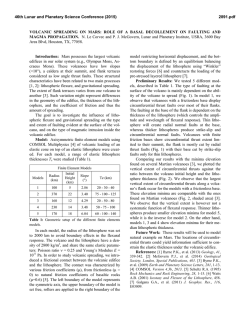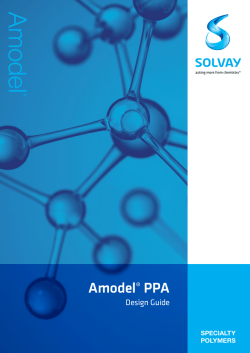
Depth of Jointing and the Transition to Normal - USRA
46th Lunar and Planetary Science Conference (2015) 1430.pdf DEPTH OF JOINTING AND THE TRANSITION TO NORMAL FAULTING IN THE LITHOSPHERES OF SOLID SOLAR SYSTEM BODIES. Christian Klimczak1 and Paul. K. Byrne2, 1University of Georgia, Department of Geology, Athens, GA 30602 ([email protected]), 2Lunar and Planetary Institute,Universities Space Research Association, Houston, TX 77058 ([email protected]). Introduction: Both the depth and amount of fracturing within planetary lithospheres are important factors in studies of large-scale geologic and geophysical processes, as both strongly influence the porosity and density [1], as well as the mechanical [e.g., 2, 3] and hydraulic [e.g., 4] properties of a lithosphere. Both also provide insight into the thickness of the lithosphere. The degree of fracturing, although difficult to determine on the lithospheric scale, can be assessed using the rock mass rating classification scheme [5]. The depth to which a lithosphere is fractured is equally difficult to quantify, although stresses arising from the impact cratering process, global contraction and expansion, or tidal deformation lead to extensive fracturing within lithospheres of many Solar System bodies. Here, we assess the potential depth of fracturing for tensile stress regimes, and compare our results with extensional brittle deformation observed on bodies across the Solar System. Jointing and normal faulting: To first order, estimates of the depth of fracturing within a lithosphere under a neutral or extensional tectonic regime may be obtained by studying the maximum depth of jointing. Joints are fractures with pure opening displacement (Mode I), where the fracture walls move apart relative to each other. When joints reach a critical size, and thus propagate to a critical depth, the overburden stresses become unfavorable for further accumulation of opening displacement alone, and instead promote shear displacement (Mode II) along the fracture surface, forming normal faults. The maximum depth at which this transition occurs can be determined using the Griffith criterion [6], which, when applied to the tensile regime, states that the difference between the most compressive (𝜎! ) and least compressive (𝜎! ) stresses is not to exceed four times the tensile strength (𝑇0 ) of the lithosphere in which the joints form. In the tensile regime, the most compressive stresses are governed by the overburden, and so for fracturing to initiate, the least compressive stresses must at least equal the tensile strength of the lithosphere. The maximum depth (𝑑max ) of jointing for a dry lithophere may therefore be estimated by: 𝑑max = 3𝑇0 𝜌𝑔 , (1) where 𝜌 is the lithospheric density and g is the surface gravitational acceleration. Pore-fluid pressures facilitate shear failure and so must be accounted for in wet lithospheres, such as those of Earth and Mars. Results: The maximum depth of jointing is depicted as a function of surface gravitational acceleration for dry and wet rocky lithospheres (𝑇! = 6 MPa; 𝜌 = 3000 kg/m! ) in Fig. 1a and for icy lithospheric conditions (T! = 500 KPa; 𝜌 ≈ 1000 kg/m! ) in Fig. 1b. Fracturing under conditions above the curves would likely involve only jointing, whereas for conditions below the curves, both Mode I and Mode II fracturing is expected to occur. The formation and displacements of joints are primarily governed by the strength properties of the host rocks, and lithospheric deformation under conditions prevalent above the curves is strength-dominated (Fig.1). The transition from jointing to normal faulting, and the ensuing accumulation of displacements on the faults, is influenced by the overburden and so is a function of g [e.g., 7]. Lithospheric deformation under conditions present below the curves is therefore gravitydominated (Fig. 1). Note that lithospheric deformation in the gravity-dominated regime for planetary bodies with relatively high values of g occurs at comparatively shallow depths, and vice versa: bodies with small surface gravitational accelerations require a substantial lithospheric thickness for normal faulting to initiate. Comparison with Solar System bodies: Most solid Solar System bodies show evidence for extensional tectonics, ranging in style from troughs, to graben, to systems of graben, to extensive rift zones. Rocky bodies. The rocky planets and moons have higher values of surface gravitational acceleration than their icy counterparts, and so lithospheric deformation is in the gravity-dominated regime. Extensional fracturing is therefore manifest as grabens on all of these bodies, even on very small scales. The transition from jointing to normal faulting is predicted to occur at depths >3 km on the Moon, which is plausible for many of the larger grabens [8]. Yet smaller grabens [e.g., 9] are possible, as they would likely be confined to the regolith or megaregolith, materials with substantially lower tensile strengths. Troughs observed on Vesta [e.g., 10], if they are graben, would require a lithospheric thickness of ~24 km for the strength and density parameters assumed in this study (Fig. 1a). Gravity-dominated deformation on icy bodies. Many icy bodies show evidence for normal faults or grabens, most prominently Saturn’s moons Rhea, Dione, and Tethys [11], as well as Uranus’ moons Titania [11], Ariel, and Miranda. As joints and grabens on these bodies have the same geomorphologic expres- 46th Lunar and Planetary Science Conference (2015) sions as their counterparts in rocky lithospheres, we assume that the Griffith criterion holds for tensile strengths of water ice [e.g., 12]. Due to their small surface gravitational accelerations, these bodies require a relatively thick brittle icy shell (a minimum of 4−19 km) for the observed normal faulting to develop, under the parameters used in this study (Fig. 1b). Strength-dominated deformation on icy bodies. The surfaces of Europa and Enceladus abound with evidence of large-scale joints, but evidence for normal faulting (i.e., relay ramps, troughs), is ambiguous. If indeed no normal faults exist on these bodies, it is likely because their lithospheres are too thin for normal faulting to occur there. If that is the case, the Griffith criterion, with the set of parameters chosen in this study, predicts that the brittle portion of Europa’s solid shell is not thicker than 1.1 km, while Enceladus has a brittle layer maximally 13 km thick. These values are in broad agreement with estimates of elastic thickness values of the icy shells of these bodies [e.g., 13, 14]. Bodies with no fracturing observed. Titan, Oberon, and Umbriel are not sufficiently well imaged to identify jointing or normal faulting. In contrast, there is no definitive evidence for any extensional tectonic activity on Callisto, Iapetus, and Mimas. Tensile stresses acting in the lithospheres of these bodies were likely not large enough to cause any fracturing at detectable scales. Implications for Pluto, Charon, and Ceres. If normal faults are observed on Pluto, Charon, and Ceres, then their lithospheres should be at least 2 km (for Pluto) and 5 km (for Charon and Ceres) thick, for the parameters we use here (Fig. 1b). Conclusions: We use the Griffith failure criterion to obtain a first-order understanding of the depths to which joints in extensional tectonic regimes on solid Solar System bodies might grow before they develop into normal faults. We find that, if fractures are present, there are two regimes in which brittle deformation will occur: strength-dominated (jointing only), or gravity-dominated (shear failure leading to normal faulting). Comparison with observed extensional deformation on select rocky and icy bodies in the Solar System provides insight into the depth of fracturing of their lithospheres. Our results indicate that most planetary lithospheres have the potential to be deeply fractured by extensional tectonic processes. Of course, impact cratering and, as for Mercury, thrust faulting are among a wide range of other processes that provide ample means by which a lithosphere can be fractured. References: [1] Wieczorek M. A., et al. (2013) Science, 339, 671–675. [2] Schultz, R. A. (1993) JGR, 89, 10,883–10,895. [3] Klimczak, C. et al. (2014) 1430.pdf AGU, P21C-3940. [4] Klimczak, C., et al. (2010) Hydrogeol. J., 18, 851–862. [5] Bieniawski Z. T. (1989) Engineering Rock Mass Classifications, John Wiley, New York, 251pp. [6] Griffith, A. A. (1924) Proceedings of the First International Congress on Applied Mechanics, 55–63. [7] Schultz, R. A., et al. (2006) JSG, 28, 2,181–2193. [8] Klimczak, C. (2014) Geology, 42, 963–966. [9] Watters, T. R., et al. (2012) Nature Geosci., 5, 181–185. [10] Buczkowski, D. L., et al. (2012) GRL, 39, L18205. [11] Byrne, P. K. & Schenk, P. M. (2014) GSA, 46, 634. [12] Voitkovskii, K. F. (1960) Makhanichaskie svcsistva I'da, 92pp. [13] Nimmo, F. & Manga, M. (2009) in Pappalardo, McKinnon, Khurana eds., Univ. Ariz. Press., 381–404. [14] Olgin, J. G. et al (2011) GRL, 38, L02201. Figure 1: Dependence of maximum depth of jointing on the surface gravitational acceleration based on the Griffith failure criterion. G: Ganymede; Ti: Titan; O: Oberon; Ce: Ceres; C: Charon. Full symbols indicate bodies that show geomorphologic evidence for normal faulting, open symbols show evidence for jointing only, and open dashed symbols indicate bodies for which large-scale extensional deformation has yet to be observed.
© Copyright 2025







